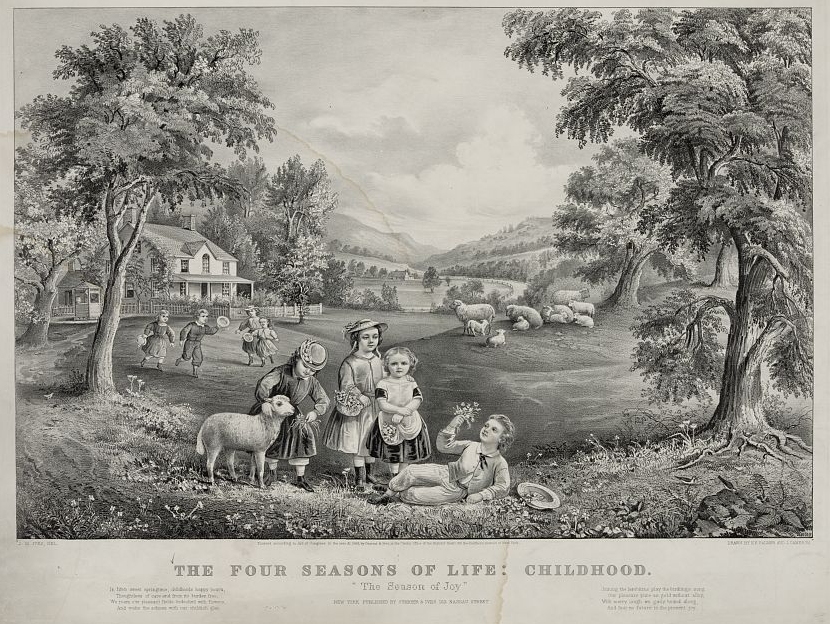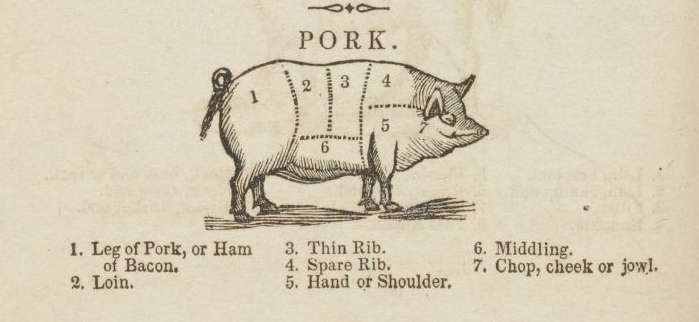Images of home decor from the past are primary sources for daily life and culture of the era. But the viewer must distinguish between idealized depictions and reality.
The printmaking firm of Currier and Ives provided prints to decorate the walls of American homes from the 1830s to the early 20th century. The firm produced over 7,500 different lithographs – prints suitable for framing. At first, the prints were black and white and artists added color by hand. Later, full color prints were mechanically produced as printing technology improved. Every aspect of American life was featured. The affordable prints were sold from the New York City office, by stores and salespeople across the nation, and by mail. Currier and Ives prints hung on the walls of homes through the 19th and into the 20th century. Catharine Beecher, the 19th century expert on home-making, gave practical advice on how to decorate tastefully on a budget and recommended inexpensive prints, or chromos, for decorating the walls.
Primary Source Analysis: Classroom Activity

Ask students evaluate the 1868 set of Currier and Ives prints on this page and describe the messages conveyed about home and family in the late 19th century
Select each image for more information.
What conclusions can be made about children? What do their activities, the clothes they are wearing, and their placement in each picture say about the expectations for childhood?
What are fathers supposed to do? In the third print in the series entitled “Middle Age” (below), the father is returning home, but from from where? Scrutinize his clothing and make conclusions about his occupation? What are mothers supposed to do according to these prints? Who is doing the hard work of cleaning and cooking behind the scenes?
Where is “home” located – in the city or the country? According to these prints, what was a home supposed to look like on the outside and inside? Note the furnishings. Would every American home in the late 1800s have carpets, a hall tree, and large pictures on the walls? Hall trees were considered requirements for upper-middle class homes of the late 19th century. Hall trees provided space for visitors to leave coats, umbrellas, and visiting cards. Did every home have space and a need for hall trees?

After students have made conclusions about family and home life in the late 19th century, ask if these prints represented daily life for everyone in America. Consider providing idealized images of middle class families from the 20th and 21st century (easy to collect using Google’s image search for “ideal American families”). Ask what’s different and what’s the same. And ask what families are NOT represented in the idealized depictions in decorative prints and advertising images. What socio-economic classes are missing? What groups of people are not represented? Do families always have a mom, dad, and two kids? Through inquiry questioning, help students see that idealized depictions of families and homes are not a new thing. Primary source images from every historical culture represent ideals that may or may not depict the reality of daily life.
So, what can home decorations tell us about the past?

What we know about decorating homes in the past often comes from sources that depict a cultural ideal. Advice books, like Catharine Beecher’s The American Woman’s Home, described what a home ought to be, not the homes that many people could actually afford. Beecher’s advice and these prints depicted the 19th century middle class ideal. Many rural and urban working class families lived in much smaller, sparse, and crowded spaces. These Currier and Ives prints are similar to advertisements and decorating magazines today – – every family is pretty, perfect and every home is neat and decorated in the newest styles. But for most of us, the reality of daily life looks very different.
For color versions of these images, see the collection of the Museum of the City of New York Currier and Ives collection.



I could use these images in my classroom as an activity to explain what families back in the 19th century looked like. For example, the middle class ideal was a dad coming home from work to his wife, who stayed at home and looked after the children, and children happily greeting the dad. This is a great example to show the stereotypical family in the late 1800s. I could also show images of very different families from that time period.